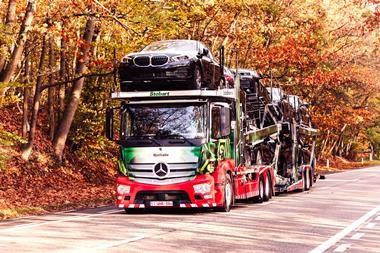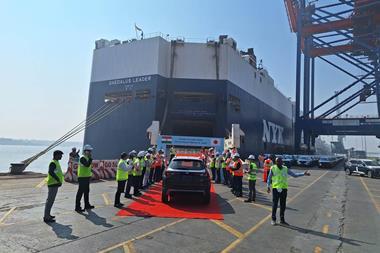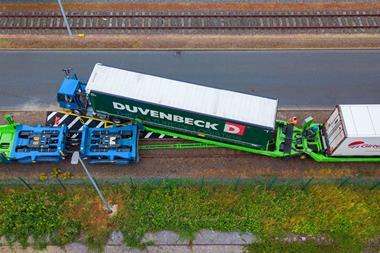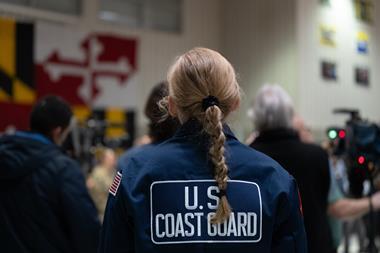Governments, carmakers, processors and carriers will all have their roles to play in establishing greater economic and logistical integration across Latin America, as Automotive Logistics finds out.
In this story...
Mexico has been the bright spot among large Latin American economies for the automotive industry. Although the country’s overall economic growth has been relatively sluggish, its competitive manufacturing costs, solid supply chain and good transport links to the US have made it a huge recipient of automotive investment, especially as an export hub to the US and Canada. Over the past two years, it has overtaken and left Brazil far behind in annual vehicle production. Its domestic market, while relatively small, has also been surging, growing at a rate of 15-20% per year over the past two years.
However, even Mexico faces uncertainty following the recent US presidential election, as carmakers with operations across Mexico, the US and Canada wait to see what Donald Trump will do following campaign pledges to renegotiate or pull out of the North American Free Trade Agreement (Nafta), which allows barrier-free trade between the three countries.
Despite the gloom and uncertainty in the wider Latin America region, there are reasons to be hopeful. Argentina appears to be moving in a more positive economic direction under the new government, and may return to healthier growth in the near future; domestic vehicle sales have been growing strongly this year. In December, Colombia’s government ratified a peace agreement with the FARC, a guerrilla movement with which Colombia has officially been at war for 50 years. In Brazil, there is at least some political stability following the ousting of Dilma Rousseff as president in August, and recent signs that the country’s industrial sector is beginning to start a recovery (albeit mildly, with concerns remaining over political corruption in the country).
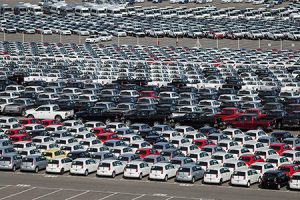
While many are worried about whether Donald Trump will take as hard a line on trade with Mexico when president as he did as a candidate, the country is still expected to see strong growth in vehicle production and exports, with more new plants under construction. Any improvement in Central and South American economies, meanwhile, will be to its benefit, thanks to Mexico’s trade agreements in the region, along with the weakening of the peso following the US election.
Indeed, exports across Latin America are coming back into focus. Brazil’s currency, the real, has also dropped sharply against the US dollar and other regional currencies, making its exports more competitive following years of decline. The potential growth in markets like Argentina, Colombia and elsewhere in South America should bode well for Brazil’s manufacturing base.
Marcelo Cioffi, a partner at PwC in São Paulo, says the sharp downturn in Brazil has created pressure to use OEMs’ installed capacity, and make up for the shrinking sales at home with exports. “All OEMs [in Brazil] will have export opportunities on their radars,” he says.
In Cioffi’s opinion, carmakers in Brazil should continue to be the main suppliers of vehicles to Latin American countries. Manufacturers such as General Motors are investing in producing more affordable cars to export to emerging countries from Brazil, including to Mexico and Argentina.
[sta_anchor id="1"]Despite political and economic barriers to export growth, vehicle trade looks to be an increasingly important topic across Latin America in the coming years, even if, in absolute terms, it will be playing catch-up with past volumes. Meanwhile, with infrastructure across the region notoriously patchy, and investment in ports substandard, logistics could be critical in helping or hindering such trade.
The art (and threat) of the dealTrade deals in Latin America are important to its inter-regional vehicle flows. The largest of these is Mercosur, which includes Brazil, Argentina, Venezuela, Paraguay and Uruguay (with other South American countries as associate members). While the agreement has led to a significant increase in trade since it was first formed in the 1990s, recent economic problems have reversed some of those gains, while Venezuela’s participation in the group is controversial and may be suspended. Nevertheless, efforts to improve the common market across Mercosur would benefit vehicle trade and logistics services.
 "All OEMs [in Brazil] will have export opportunities on their radars." - Marcelo Cioffi, PwC
"All OEMs [in Brazil] will have export opportunities on their radars." - Marcelo Cioffi, PwC
The Pacific Alliance, established in 2012, currently includes Mexico, Chile, Colombia and Peru. Although smaller overall, the group is more export oriented than Mercosur. Tomasz Karol Lis, head of Latin America for Höegh Autoliners, which has significant shipping services in the region, says the alliance is opening new markets for vehicle producers. “This allows lower prices in other markets,” he adds.
Simónides Vasco Vélez, key account manager at the Colombian port of Sociedad Portuaria Puerto Bahia, also views the Pacific Alliance as important in facilitating trade between the four countries by reducing trade barriers, and speeding up import operations. Vasco Vélez says that Colombia and Mexico have the strongest vehicle manufacturing industries in the alliance. “Strong trade agreements, with sustainable [economic] growth in these countries, can lead to major development opportunities for Colombia’s vehicle manufacturers,” he claims.
However, increasing exports is often fraught with difficulties. Carmakers must navigate complex political negotiations and shifting economic factors, from volatile currency swings, hard-fought free trade agreements and poor infrastructure, through to complex local rules and regulations.
Expanding free trade agreements seems to have entered a difficult phase, for example. As well as the threat to Nafta, Donald Trump has already said that he will pull the US out of the Trans-Pacific Partnership on his first day in office, a trade deal that included 12 Pacific countries in Asia and the Americas, including Mexico, Peru and Chile. Without the US, that deal looks to be dead or significantly less relevant.
Indeed, vehicle manufacturers and logistics specialists speak of a complex balancing act. South America, in particular, is characterised by governments and manufacturers broadly wary of imports that hurt vehicles produced by their local plants and workers. Even in countries that do not yet have their own plants, governments often want to attract OEMs to set up manufacturing and so discourage imports.
For instance, Brazil – which slapped a punitive tariff on imports earlier this decade to stem their rise – also reneged on an earlier agreement to trade vehicles freely with Mexico. Instead, in March 2015, it agreed to extend a quota-based agreement on automotive trade for four years. The deal allows for a 3% increase each year in exports (compared to 7% in an earlier agreement). A non-quota system is scheduled to come into force in 2019, but may be subject to further wrangling.
While trade agreements help to open up trade, working across a proliferation of agreements can also cause difficulties. Höegh’s Lis points out that countries in the Pacific Alliance have varying rules for emissions and safety regulations compared to Nafta or the EU. The result is different product specifications for different markets.
[sta_anchor id="2"]However, here too there may be some hope, at least in the long term. In 2016, the EU and Mercosur resumed trade talks that set out to establish a trade deal by 2018 – though such timing could be overly ambitious, not least in the context of the EU negotiating with the UK over Brexit.
The Mexican exampleMexico’s automotive industry has set the gold standard for how an open, free trading economy with good logistics links can benefit automotive production and exports. Dietmar Ostermann, automotive partner at PwC, points out that the industry’s growth is largely based on having labour costs for fully loaded vehicle assembly of around $6 per hour in most of Mexico versus $44-$54 in the US. Overall, the cost-per-vehicle of assembly in Mexico is about $800-$1,200 cheaper than in the US, he estimates.
Mexico’s success is also down to the supply chain and logistics. Its automotive supply chain is well developed, while it has reasonably good rail links to ports and across the border to the US and Canada. The country also has favourable trade agreements that cover around 45 countries.
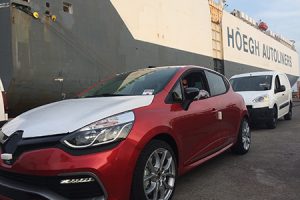 Höegh sees trade deals like the Pacific Alliance as a positive driver of vehicle flows in Latin America
Höegh sees trade deals like the Pacific Alliance as a positive driver of vehicle flows in Latin America“Mexico is a great location to produce cars and light trucks, and then to export them around the world. Labour costs, quality of workers, supplier availability and capabilities, as well as trade agreements all favour this location,” Ostermann says.
Along with American carmakers – who are increasingly using Mexico as a hub to build smaller vehicles, as well as some light trucks – European and Asian carmakers have invested in the country as an export hub for vehicle shipments worldwide. For example, Ostermann predicts that around half or more of the vehicles produced in the new BMW plant under construction in the central Mexican city of San Luis Potosi, which will open in 2019, will eventually leave North America, with Latin American demand one of several prime targets, he says.
Audi’s new plant in San José Chiapa, which opened in summer 2016, is the primary source of the new Q5 SUV and will export a substantial portion of its volume beyond North America, especially to Europe and Latin America.
As such, OEMs view Mexico as an important part of their North American and global manufacturing strategies. Current forecasts – before any changes to Nafta can be accounted for – see vehicle assembly in Mexico rising by more than 50% in the next seven years to approach 5.5m units by 2022, from about 3.5m currently. Currently, more than 80% of production is exported, with 80-90% of that share going to the US and Canada. South American [sta_anchor id="3"]shipments have declined in recent years with the fall in the Brazilian market, especially.
However, Ostermann expects more volume will go to Latin America as Brazil and others recover. “There’s barely a better place in the world for vehicle assembly for global production [than Mexico],” Ostermann adds.
Brazil looks abroadIn recent years, OEMs have pumped investment into expanding or building plants based in Brazil’s huge domestic market, which had grown to a record 3.8m light vehicle sales in 2012 and was expected to have surpassed 5m units already. However, vehicle sales could finish 2016 at less than 2m units, after four years of falls and a deep recession over the past year.
Exports have been a bright spot, though; in the first 11 months of 2016, Brazilian light vehicle exports had grown by nearly 25% compared to the same period in 2015.
However, although many OEMs intend to expand their export base from Brazil, it is not enough to overcome falls in the domestic market; overall light vehicle production in 2016 was still down by around 17% from 2015’s weak levels. In fact, Brazil is still trailing previous export highs earlier in the decade. Cioffi warns that even with a competitive Brazilian real against the US dollar, and various government initiatives, volumes are recovering at a snail’s pace. Weak market conditions in Brazil’s neighbouring countries mean that customers are unable or unwilling to purchase vehicles.
Meanwhile, Brazil’s high cost structure limits growth, making it hard to compete with the likes of Mexico. Some important developments will be needed through coordinated efforts by the government in areas such as labour and tax reform, infrastructure investment and favourable energy costs, Cioffi notes.
[sta_anchor id="4"]As for vehicle imports, these will depend on a rebound in the local market, exchange rates, and new regulations that may arise from the end of Brazil’s Inovar programme in 2017, he explains. Inovar was implemented to encourage local manufacturing, but is under scrutiny by the WTO after other countries complained it was discriminatory.
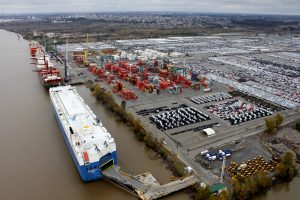 Argentina’s main vehicle-handling terminal, Zarate, is offering ‘all-in-one’ logistics services for imports after operating at half its throughput capacity in 2016
Argentina’s main vehicle-handling terminal, Zarate, is offering ‘all-in-one’ logistics services for imports after operating at half its throughput capacity in 2016Argentina picks upIn Argentina, Alejandro Van Thillo, general manager for Terminal Zarate’s vehicle division, recalls that before the Brazilian crisis, imports from Argentina accounted for about 10% of Brazil’s domestic sales and about 50% of Argentine vehicle production. With Brazilian sales in the doldrums, the balance has shifted to Argentina importing more vehicles from Brazil than it exports to its neighbour.
That is in part because the Argentine vehicle sales market – one of the region’s most volatile – has shown some recovery this year. Domestic sales to dealers were up 17% year-on-year in the first ten months of 2016, to 587,000 units. But while imports have risen, exports are down by nearly 30% in the same period, leading to an overall production drop.
Terminal Zarate, which is close to Buenos Aires and is the country’s main vehicle-handling terminal, has been operating at half of its throughput capacity, and expects around 450,000 vehicles in 2016. The terminal has focused its efforts on boosting process productivity, maintenance services, technology upgrades and on-demand solutions. According to Van Thillo, the terminal is also looking into offering “all-in-one” logistics services for imports, such as vessel operations, storage, stock maintenance, pre-delivery inspection, distribution and ground transport to dealers.
Van Thillo says that previous obstacles to customs clearance and import restrictions between Brazil and Argentina were removed over the last year, and vehicle turnover in Zarate’s bonded yard returned to “almost normal” waiting periods of 2-5 days. That improvement came after removing a number of documentation requirements that had slowed approval to an average of 9-10 days, or peaks of more than 20 days.
 "Conditions are positive for the Colombian automotive industry to create a wider market and a positive environment for the car industry." - Simónides Vasco Vélez, Puerto Bahia
"Conditions are positive for the Colombian automotive industry to create a wider market and a positive environment for the car industry." - Simónides Vasco Vélez, Puerto Bahia
Van Thillo is optimistic that Argentina is nearing the end of its own economic and political crisis, and should begin a transition in 2017. The country’s vehicle sales have been supported by discounts and sales campaigns by carmakers; however, production has been restrained – in part because of the drop in Brazilian demands – and has decreased by around 13% in 2016 compared to 2015.
From Zarate’s point of view, finished vehicle imports and exports for 2017 should show a slight uptick. Van Thillo notes that this will depend on the Brazilian market, which itself seems to be some years away from approaching its previous high volumes. Still, the situation is in many ways an improvement from recent years, when Brazil and Argentina were effectively engaged in a trade war.
Carmakers in Argentina have been seeking new export markets, which include Australia, South Africa and other Latin American countries such as Mexico, but they will will face tough competition because of Argentina’s relatively [sta_anchor id="5"]high labour costs, inflation and the impact of currency adjustments.
Terminal Zarate remains an important regional shipping hub, with major pure-car-and-truck-carriers calling, as well as barge lines for trans-shipments to Paraguay and Uruguay.
Colombia’s peace dividendSociedad Portuaria Puerto Bahia in Colombia also anticipates a higher influx of imported vehicles. Simónides Vasco Vélez expects economic conditions to pick up following the peace accord with the FARC guerrillas, which the government agreed in early December (after an earlier version was narrowly rejected in a referendum). Colombia – the second most populous country in South America after Brazil – should grow based on mounting investor confidence, poverty reductions and a burgeoning middle class, Vasco Vélez explains.
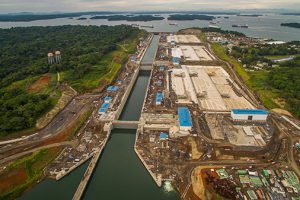 The growth in vessel size made possible by the widening of the Panama Canal could see a rise in trans-shipment of vehicles in the region
The growth in vessel size made possible by the widening of the Panama Canal could see a rise in trans-shipment of vehicles in the regionPuerto Bahia, a 20-hectare specialised ro-ro terminal located near Cartagena, has positions for two vessels simultaneously and capacity to handle 120,000 units per year, with priority docking for ro-ro vessels. Since starting in October 2015, the terminal has handled 16,000 vehicles and 900 units of equipment and trucks.
The terminal has 1,000 sq.m for PDI and 3,800 sq.m for storage. It is targeting local OEMs and the trans-shipment market in the Caribbean. Renault Sofasa – which builds Renault cars in Colombia – Toyota, Suzuki, Kenworth, Dina and Volvo Trucks use the terminal. NYK Autologistics designed its storage areas, flow and operational standards.
Given the depreciation of the Colombian peso, Vasco Vélez expects 2016 will finish with an overall reduction in imports of around 15% compared to 2015. Nonetheless, he envisages a recovery in 2017 based on tax reforms, the country’s low vehicle penetration rate, and Colombians’ willingness to replace ageing cars. Colombia has 102 vehicles per 1,000 inhabitants, compared to 239 in Chile and 320 in Argentina.
[sta_anchor id="6"]Puerto Bahia invested $160m in infrastructure, operational systems and qualified personnel to handle the higher volumes arriving at the terminal. The company plans to expand the berth by another 300 metres, as well as to improve PDI facilities and IT. “Conditions are positive for the Colombian automotive industry to create a wider market and a positive environment for the car industry,” says Vasco Vélez.
Turning the page to a better storyThere is no question that South America, in particular Brazil, has seen a downgrade in its outlook compared to a few years ago. However, wider changes in the region may lead to further economic and supply chain integration, encouraged by stronger trade agreements and logistical links.
Shipping routes also have an influence on vehicle trade across Central and South America. Mexico is seeing more activity and links across the wider region. Höegh, for example, currently calls at Mexican ports 12-13 times per month with deep-sea and short-sea trades, using the Gulf coast ports of Veracruz (the country’s largest) and Altamira. By connecting its new Caribbean and Mexican Gulf short-sea service with deep-sea trades, the carrier also covers the US gulf coast, the Caribbean, central and South America.
Höegh has also been investing in equipment to handle project cargo and breakbulk at Veracruz and Altamira ports, according to Tomasz Lis.
The recent Panama Canal expansion could also play a role. Albano Aguilar, a trade specialist at the Panama Canal Authority, says that since the inauguration of the expanded canal in June, more cargo is consolidated on larger neo-Panamax vessels. New car carriers, meanwhile, are able to transport 30% more vehicles, a total capacity of around 8,500 car equivalent units, through the expanded canal. That could lead to more trans-shipment of vehicles in the region.
[sta_anchor id="7"]Much will depend on governments in Latin America, whether in economic reform and stimulus, opening up trade, or indeed investing in needed infrastructure. But manufacturers and logistics providers will also set the pace by adjusting services and partnerships to meet new potential demand. If that happens, there will be more good news to counter the recent woes in the region.
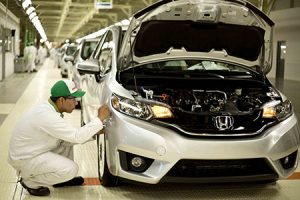 Honda exports to the US, Latin America and other regions via both the east and west coasts of Mexico
Honda exports to the US, Latin America and other regions via both the east and west coasts of MexicoAn example of Mexico’s global export potential can be seen at Honda, which has expanded production and exports from the country.
Charles Franklin, logistics manager for the export sales division at American Honda Motor, is responsible for exports from the US, Canada and Mexico that go beyond North America. Honda has recently created a regional export logistics programme, replacing a country-by-country structure. The manufacturer also continues to develop relationships with its logistics providers in Mexico, adjusting programmes as needed to support customer expectations, Franklin says.
Honda’s Celaya plant, which opened in 2014, plays an important role in exporting vehicles to Latin America and other regions, building the compact Fit and the HR-V, a subcompact SUV. The company also has another plant in El Salto, in Guadalajara, that had produced the CR-V compact SUV, but is switching production to the hot-selling HR-V.
Both plants export to the rest of Latin America, along with other Honda plants in North America and Asia. Franklin notes that, as Honda looks to make use of its global plant capacity, it could also serve Latin America from other countries, such as India, which also produces the Honda Civic. “Demand is model-specific so it depends on what each country orders,” he says.
In partnership with Honda’s logistics providers, the manufacturer is continually working to improve the logistics process. It has partnered with port processors to certify vehicles for global destinations, and it supports facility improvements that help this. Honda has also made adjustments to its transport methods, both in and out of the area, to ensure the secure transit of vehicles. For example, Honda exports from Mexico are moved by truck from Celaya to the east and west coasts for shipping, according to Franklin. That is in contrast to Honda exports to the US (read more about Honda's logistics operations in the US), which move by rail to the ports; given the low frequency of sailings to many of Honda’s global destinations, truck allows it to be more flexible in meeting sailings.
Indeed, while Mexico is seeing an increase in vehicle trade, its infrastructure can often cause problems. Höegh’s Tomasz Lis sees traditional transport modes, such as rail and road, becoming increasingly congested in Mexico. As a response, Mexican manufacturers are looking for multimodal solutions, involving short-sea transport to the US. This becomes even more visible with the high rate of crime affecting rail and truck transport, where theft, vandalism, and smuggling are deterring OEMs from using pure land modes, he notes.
Honda’s Franklin adds that Mexico’s logistics infrastructure is reaching its limits as the manufacturing sector continues to expand. “Access to ports can be challenging and space is set at a premium,” he notes.


















